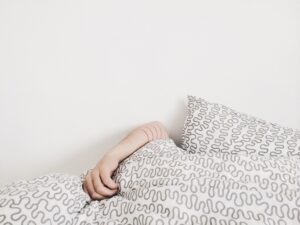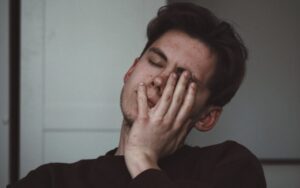21st century living has contributed to the addition of 14 new Disorders in the DSM-5
The Diagnostic and Statistical Manual of Mental Disorders (DSM) is the standard classification of mental disorders used by mental health professionals around the world. The manual is the guide by which mental health professionals base their diagnosis. Below is a list in alphabetical order of the 15 new disorders added to the DSM-5.
1. Binge Eating Disorder
People with this disorder eat large amounts of food when they’re not hungry. Usually consumed when the person is alone or hidden from view. The food is consumed very quickly and quite often done to the point of creating physical pain. Food is often used as a distraction to avoid dealing with other problems. After a binge eating episode the person may feel disgusted with themselves and become depressed. Binge eating disorder is similar to Bulimia nervosa but not the same. Even though they both experience similar feelings of disgust and guilt, binge eating disorder is characterised by the absence of purging.
2. Caffeine Withdrawal
Not everybody believes that caffeine can have quite a bit of a withdrawal impact to the point of bringing about mental issues. Unlike the withdrawal side effects that originate from addictions to other illegal drugs and alcohol.
3. Cannabis Withdrawal
Another controversial entry into the DSM-5 as studies have previously shown the existence of marijuana addiction, but critics are not so convinced about cannabis withdrawal. Cannabis withdrawal can be treated the same way as withdrawal from other illicit drugs.
4. Central Sleep Apnoea
In Central Sleep Apnoea breathing stops and there’s a pause before the person starts to breathe again. Loud snoring is not present, nor is a blocked airway, unlike that of Obstructive Sleep Apnoea where the person with the condition struggles to breath against blocked airways. This entry is an updated version of a known medical and psychological condition affecting a person’s sleep that now matches current medical knowledge of sleep disorders
5. Disinhibited Social Engagement Disorder
A disorder in children that is often mistaken for ADHD that is characterised by inattentive and impulsive behaviour. The DSM – 5 defines the disorder as, “a pattern of behaviour in which a child actively approaches and interacts with unfamiliar adults.” Theravive.com describes the condition, “It is a trauma and stressor related disorder that develops as a result of severe neglect during the first two years of life.” Commonly found in children who during their infancy have been neglected, inconsistently cared for and have spent their infancy in an institution.
6. Disruptive Mood Dysregulation Disorder- DMDD
This particular disorder affects only children under the age of 18. These kids have severe temper tantrums defined as “extreme, explosive rages.” They have severe, chronic and persistent irritability and anger displayed as a temper tantrum and outbursts that occur frequently. The DSM-5 describes it as,” Far beyond temper tantrums, DMDD is characterized by severe and recurrent temper outbursts that are grossly out of proportion in intensity or duration to the situation.”
7. Excoriation (Skin-picking) Disorder
Characterised by the constant recurring picking and scratching of the skin to the point of causing skin lesions and scars causing impairment of physical social and normal occupational functioning, the symptoms of this disorder may not be better explained by the symptoms of another disorder. Also known as dermatillomania.
8. Hoarding Disorder
Psychologists consider this a very real condition defined as “persistent difficulty discarding or parting with possessions due to a perceived need to save the items and distress associated with discarding them.” A person with a hoarding disorder often turns their home into a place of storage to the point where navigating from one room to another is very difficult due to the amount of accumulated belongings. Often there’s difficulty in opening doors due to items blocking their movement. Hoarder’s homes usually need a biohazard team of cleaners to toss out and make the home hygienic and make living spaces available to be used as originally intended.
9. Hypersexual Disorder
- Sexual addiction now has an official listing in the DSM. However, due to it being listed in section III as needing further investigation, no formal diagnosis can be given. The term ‘Sexual Addiction’ first showed up in the DSM-3 in 1980 but was later removed in the 1994 edition.
- Major Neurocognitive Disorder with Lewy Body Disease and Mild Neucognitive Disorder (NCD)
- Major NCD is characterised by significant cognitive decline, interference with independence. Not due to delirium and not due to other mental disorders with the exception of Alzheimer’s.
- Mild NCD is characterised by mild cognitive decline, does not interfere with independence and is not specified to be due to other mental disorders or delirium.
10. Premenstrual Dysphoric Disorder – PMDD
A depressive disorder. Controversy exists over PMDD being an actual disorder and considered by critics to be nothing more than a severe case of Premenstrual Syndrome (PMS). PMDD as it is known can affect normal daily and occupational function. The symptoms can consist of brain fog, lethargy, depression, mood swings, a change of appetite, feeling out of control, overwhelmed, sleep problems i.e. Insomnia or sleeping too much, difficulty concentrating, breast tenderness, difficulty focussing, headaches, joint and muscle pain, severe anger or rage, crying, feelings of being overwhelmed, fatigue, bloating, weight gain, insomnia, Hypersomnia, marked anxiety and panic attacks, lethargy, fatigue, lack of energy, marked appetite change, decreased interest in usual activities, feelings of hopelessness and increased interpersonal conflicts. Symptoms often disappear during the onset of menses. Other unlisted symptoms may also be present.
11. Rapid Eye Movement Sleep Behaviour Disorder
Often called REM Behaviour Disorder; this condition is characterised by acting out dreams while sleepwalking. Often this can cause injuries to their bed partner and to themselves. Behaviours can manifest in other ways, from mild muscle twitching to severe grabbing, and the use of other more complex motor behaviours. This disorder falls under the category of Sleep-Wake disorders.
12. Restless Legs Syndrome
Also known as the Willis-Ekbom’s Disease, it affects up to 10 percent of people in the U.S. Often people with the syndrome feel uncomfortable sensations in their legs and a strong urge to move them in order to stop the feelings. The condition can occur on one side of the body but mostly affect both legs. The movement makes it hard or impossible to get enough sleep.
13. Sleep-related Hypoventilation
The condition is similar to Central Sleep Apnoea, a breathing disorder where the patient is not getting enough co2 (oxygen). They have a rapid heartbeat, feel light headed and out of breath. This may cause them to experience fainting, dry mouth, sore chest muscles, anxiety, dizziness, fatigue and even having difficulty swallowing. Other symptoms are sweating, concentration and memory problems, vision changes, headache and bloating.
14. Social (Pragmatic) Communication Withdrawal
This condition includes symptoms of inappropriate responses in conversation either in written or verbal form limiting effective communication, academic achievement, social relationships and occupational performance. However, it is unrelated to autism or diminished cognitive ability.
Sandra Ciminelli
Cred.Dip.Couns.(Christian)
Sources
Market Watch – DSM Overhaul Stirs Controversy
http://www.marketwatch.com/story/dsm-overhaul-stirs-controversy-2013-05-22
Psychology Today – Sex Addiction Beyond the DSM-5
https://www.psychologytoday.com/blog/sex-lies-trauma/201212/sex-addiction-beyond-the-dsm-v
Eating Disorders – Binge Eating Disorder
http://www.eatingdisorders.org.au/eating-disorders/binge-eating-disorder
Therive.com – Disinhibited Social Engagement Disorder
http://www.theravive.com/therapedia/Disinhibited-Social-Engagement-Disorder-DSM–5-313.89-(F94.2)
Sleep Health Foundation – Central Sleep Apnoea
http://www.sleephealthfoundation.org.au/files/pdfs/Central-Sleep-Apnoea.pdf
Psych Central – Symptoms of Disruptive and mood Dysregulation Disorder
http://psychcentral.com/disorders/symptoms-of-disruptive-mood-dysregulation-disorder/
Sleep disorders guide – Hyperventilation
http://www.sleepdisordersguide.com/hyperventilation.html




Have you thought about becoming a qualified counsellor? It’s a great opportunity to learn how you can extend God's love and grace to the hurting out in the community.
For those who would like to enrol in aifc’s accredited Christian counselling courses we have two intakes per year for courses commencing around the following months:
Enrolment Season - opens approximately 2 months prior to our courses commencing. Enrol online here during our enrolment season.
We also offer two modes of study:
A Master of Counselling course was introduced in 2018.